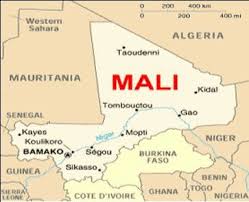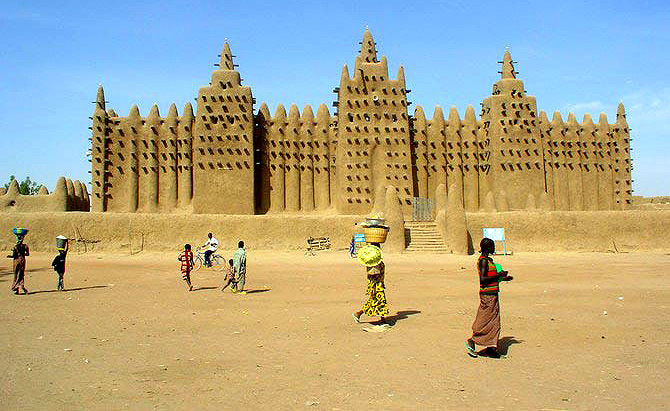
Timbuktu is an ancient city in Mali, situated 20 kilometres (12 miles) north of the Niger River. It is the capital of the Tombouctou Region, one of the eight administrative regions of Mali, having a population of 32,460 in the 2018 census.
Archaeological evidence suggests prehistoric settlements in the region, predating the city’s Islamic scholarly and trade prominence in the medieval period. Timbuktu began as a seasonal settlement and became permanent early in the 12th century. After a shift in trading routes, particularly after the visit by Mansa Musa around 1325, Timbuktu flourished, due to its strategic location, from the trade in salt, gold, and ivory. It gradually expanded as an important Islamic city on the Saharan trade route and attracted many scholars and traders before it became part of the Mali Empire early in the 14th century. In the first half of the 15th century, the Tuareg people took control for a short period, until the expanding Songhai Empire absorbed it in 1468.
A Moroccan army defeated the Songhai in 1591 and made Timbuktu their capital. The invaders established a new ruling class, the Arma, who after 1612 became virtually independent of Morocco. In its golden age, the town’s Islamic scholars and extensive trade network supported an important book trade. Together with the campuses of the Sankoré Madrasah, an Islamic university, this established Timbuktu as a scholarly centre in Africa. Notable historic writers, such as Shabeni and Leo Africanus, wrote about the city. These stories fuelled speculation in Europe, where the city’s reputation shifted from being rich to mysterious. The city’s golden age as a major learning and cultural centre of the Mali Empire was followed by a long period of decline. Different tribes governed until the French took over Mali in 1893, in a regime that lasted until the country became the Republic of Mali in 1960.
In recent history, Timbuktu faced threats from extremist groups leading to the destruction of cultural sites; efforts by local and international communities have aimed to preserve its heritage. The city’s population has declined as a result of the recent issues.
Like other important Medieval West African towns such as Djenné (Jenné-Jeno), Gao, and Dia, Iron Age settlements have been discovered near Timbuktu that predate the traditional foundation date of the town. Although the accumulation of thick layers of sand has thwarted archaeological excavations in the town itself, some of the surrounding landscape is deflating and exposing pottery shards on the surface. A survey of the area by Susan and Roderick McIntosh in 1984 identified several Iron Age sites along the el-Ahmar, an ancient wadi system that passes a few kilometers to the east of the modern town.

An Iron Age tell complex located nine kilometres (5+1⁄2 mi) southeast of the Timbuktu near the Wadi el-Ahmar was excavated between 2008 and 2010 by archaeologists from Yale University and the Mission Culturelle de Tombouctou. The results suggest that the site was first occupied during the 5th century BC, thrived throughout the second half of the 1st millennium AD and eventually collapsed sometime during the late 10th or early 11th-century AD.
Timbuktu has acquired a reputation in the Western world as an exotic, mysterious place, but the city was once a well known trade center and an academic hotspot of the medieval world. Timbuktu reached its golden period under the Mali Empire in the 13th and 14th centuries. Distinguished Malian Mansa Mūsā brought great fame to the city by recruiting scholars from throughout the Islamic world to travel there, establishing it as a center of learning. The scholars focused not only on Islamic studies, but also history, rhetoric, law, science, and, most notably, medicine. Mansa Mūsā also introduced Timbuktu, and the Mali Empire in general, to the rest of the medieval world through his Hajj, as his time in Mecca would soon inspire Arab travelers to visit North Africa. Europeans, however, would not reach the city until much later, due to the difficult and lengthy journey, thus garnering the city an aura of mystery.
Timbuktu primarily gained its wealth from local gold and salt mining, in addition to the trans-Saharan slave trade. Gold was a highly valued commodity in the Mediterranean region and salt was most popular south of the city, though arguably the biggest asset Timbuktu had was its location. The city is situated nine miles from the Niger River, making for good agricultural land. Its position near the edge of the Sahara Desert made it a hub for trans-Saharan trade routes. Timbuktu also acts as a midpoint between the regions of North, West, and Central Africa. Because of this, Timbuktu developed into a cultural melting pot.
The Mali Empire reached a steady decline in the mid-1400s, giving rise to the Songhai Empire. However, the city of Timbuktu entered a brief period of rule under the Tuaregs before it fell to the Songhai people. Despite major shifts in power, Timbuktu generally flourished until the Moroccans invaded the Songhai Empire in 1590 and began to occupy Timbuktu in 1591, after the Battle of Tondibi. In 1593, many of the city’s scholars were executed or exiled for disloyalty to the new rulers. This, along with a decline in trade as a result of increased competition from newly available trans-Atlantic sailing routes, caused the city to lose its prominence. In the 1890s Timbuktu was formally incorporated into the French colony of Sudan, remaining under French control until the colony became the independent nation of Mali in 1960.
Today, the population of Timbuktu has substantially decreased since its estimated peak of 100,000 people in the medieval period. The city has suffered from great poverty for several years now, relying on government funding as a means of survival.
On 8 August 2023, Timbuktu was brought under a total blockade by Jama’at Nasr al-Islam wal Muslimin (JNIM), exacerbating poverty, and leading to food shortages. 33,000 fled the city and its surrounding areas and 1,000 have fled to Mauritania since the start of the siege. The siege began after the withdrawal of MINUSMA, the United Nations mission to Mali during the Mali War.

